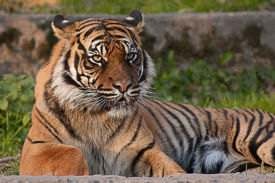Lions and tigers, both magnificent apex predators, often evoke images of raw power and untamed wilderness. While frequently compared, discerning their differences, especially in size, reveals fascinating aspects of their evolutionary paths and ecological roles. Both belong to the Panthera genus and are considered “big cats,” but when it comes to sheer size, the tiger generally reigns supreme. This article delves into a detailed comparison of Tiger Size Compared To Lion, exploring various physical attributes and shedding light on which of these iconic felines truly holds the title of the largest cat.
Lion vs Tiger: A Detailed Size Comparison
The question of “who is bigger, a lion or a tiger?” is a common one. While both are formidable creatures, statistically, tigers tend to be larger and heavier than lions. However, it’s not a straightforward answer as size can vary depending on subspecies, habitat, and individual animals.
Lion Size and Weight
Lions (Panthera leo) are impressive animals, with males, in particular, known for their imposing manes. African lions are generally larger than their Asiatic counterparts found in India’s Gir Forest.
- Weight: Male African lions typically weigh between 330 to 550 pounds (150 to 250 kg). Females are significantly lighter, averaging 243 to 350 pounds (110 to 160 kg).
- Body Length: Males measure about 5.6 to 8.2 feet (1.7 to 2.5 meters) from head to body, while females are slightly smaller at 4.6 to 5.7 feet (1.4 to 1.75 meters).
- Shoulder Height: Male lions stand approximately 3.5 to 3.9 feet (1.07 to 1.2 meters) tall at the shoulder, with females being shorter, ranging from 2.6 to 3.5 feet (0.8 to 1.07 meters).
Tiger Size and Weight
Tigers (Panthera tigris) are the largest living cat species, with different subspecies exhibiting variations in size. The Siberian tiger (Panthera tigris altaica), also known as the Amur tiger, is the largest subspecies, while others like the Sumatran tiger are considerably smaller.
- Weight: Male tigers generally weigh between 400 to 670 pounds (180 to 300 kg), and can exceptionally reach up to 857 pounds (390 kg). Females weigh considerably less, ranging from 220 to 370 pounds (100 to 170 kg). Siberian tiger males can be even heavier.
- Body Length: Tigers are longer than lions, with males measuring from 8.2 to 13 feet (2.5 to 4 meters) in total length, including the tail. Females are smaller, ranging from 6.6 to 9 feet (2 to 2.75 meters).
- Shoulder Height: Adult tigers typically stand 2.3 to 4.0 feet (0.7 to 1.22 meters) tall at the shoulder.
 A magnificent Bengal tiger in its natural habitat, highlighting its striped coat and muscular frame.
A magnificent Bengal tiger in its natural habitat, highlighting its striped coat and muscular frame.
Size Comparison Table: Lions vs Tigers
To visualize the size differences, here’s a comparative table:
| Feature | Lion (Male) | Tiger (Male) |
|---|---|---|
| Weight | 330-550 lbs (150-250 kg) | 400-670 lbs (180-300 kg) |
| Body Length | 5.6-8.2 ft (1.7-2.5 m) | 8.2-13 ft (2.5-4 m) |
| Shoulder Height | 3.5-3.9 ft (1.07-1.2 m) | 2.3-4.0 ft (0.7-1.22 m) |
Note: These are average ranges. Exceptional individuals may exceed these measurements.
As the table indicates, tigers generally outweigh lions and possess a longer body length. While shoulder height can overlap, the upper range for tigers can be taller, especially for Siberian tigers.
Physical Attributes Beyond Size: Contributing Factors
While size is a primary differentiator, other physical characteristics contribute to the overall perception of size and strength.
Mane vs Stripes
The lion’s most distinctive feature, the mane, visually enhances its size, particularly around the head and neck. This ruff of fur can make a male lion appear larger and more intimidating, especially during confrontations with rivals or prey. The color and size of the mane also indicate age and health.
Tigers, on the other hand, are characterized by their striking stripes. These stripes, while serving as excellent camouflage, don’t contribute to an illusion of increased size. Instead, they help the tiger blend seamlessly into its forest or grassland habitats, aiding in ambush predation.
Build and Musculature
Both lions and tigers are powerfully built, but subtle differences exist. Lions are known for their robust bone structure, giving them considerable physical strength. Tigers, however, tend to have a slightly more muscular build, with a higher percentage of muscle mass. This contributes to their agility, striking power, and ability to take down large prey.
Habitat and Size: Environmental Influences
The environments lions and tigers inhabit also play a role in their size and physical development.
Lions primarily live in open savannas and grasslands, where cooperative hunting in prides is advantageous. Their prey often consists of large ungulates in open areas, and their social structure aids in both hunting and defense.
Tigers, in contrast, are typically solitary creatures dwelling in dense forests, mangrove swamps, and grasslands. Their solitary hunting style requires them to be powerful enough to take down prey alone. The larger size of tigers, especially those in colder regions like Siberia (Siberian tigers), could be an adaptation to survive in colder climates and hunt larger prey found in these environments. Bergmann’s rule, which suggests that animals in colder climates tend to be larger, could be a factor in the larger size of Siberian tigers.
Diet and Size: Predatory Needs
The diet of lions and tigers is primarily carnivorous, but their hunting strategies and prey preferences differ, potentially influencing their size.
Lions often hunt in groups, enabling them to take down very large prey, including zebras, wildebeests, and buffaloes. While individual lions are powerful, their social hunting allows them to tackle prey that might be too challenging for a single cat.
Tigers are predominantly solitary hunters, relying on stealth and power to ambush prey. Their diet includes deer, wild pigs, and even larger animals like gaur and water buffalo. The need to hunt and kill prey alone might necessitate a larger size and greater individual strength in tigers.
Brain Size and Intelligence: Correlation with Size
Interestingly, tigers have been found to possess the largest brain size among big cats, even larger than lions. While brain size isn’t a direct measure of intelligence, it can correlate with cognitive abilities and problem-solving skills. Some theories suggest that the solitary lifestyle of tigers, requiring more individual decision-making and hunting strategies, may have contributed to the evolution of a larger brain size. This greater brain capacity, combined with their physical prowess, further solidifies the tiger’s position as a highly adaptable and formidable predator.
Fight Comparison: Does Size Matter?
In hypothetical scenarios of a fight between a lion and a tiger, size, along with other factors like aggression, fighting style, and individual temperament, would play a crucial role. While both are incredibly powerful, the tiger’s slight advantage in size and musculature, coupled with its tendency to fight on its hind legs and utilize both front paws simultaneously, could give it an edge. However, such encounters are extremely rare in the wild due to geographical separation.
Hybrids: Ligers and Tigons – Exaggerated Size
The size difference becomes even more pronounced in hybrids. Ligers, the offspring of a male lion and a female tiger, often grow to be significantly larger than both parent species, making them the largest cats in the world. This phenomenon is due to genetic factors related to growth-inhibiting genes. Tigons, the offspring of a male tiger and a female lion, are generally smaller than both parents, and certainly smaller than ligers. These hybrids, found only in captivity, further emphasize the size potential within these species’ genetic makeup.
Conclusion: Tiger Triumphs in Size, Both are Apex Predators
In conclusion, when directly comparing tiger size to lion size, tigers generally emerge as the larger cat species. They typically outweigh lions, possess longer bodies, and can reach comparable or slightly greater shoulder heights, particularly the Siberian tiger subspecies. While lions possess their own impressive physical attributes and the visual grandeur of a mane, the statistical and biological evidence points towards the tiger claiming the title of the largest cat. However, both lions and tigers are apex predators, each uniquely adapted to their environments, embodying power, beauty, and a vital role in their respective ecosystems. Their differences, including size, only enrich the tapestry of the natural world.
References
Diffen.com. “Lion vs Tiger.” Diffen LLC, n.d. Web. 13 Feb 2025. <https://www.diffen.com/difference/Lion_vs_Tiger>
Britannica. “Lion.” Encyclopædia Britannica, Encyclopædia Britannica, Inc. https://www.britannica.com/animal/lion
Britannica. “Tiger.” Encyclopædia Britannica, Encyclopædia Britannica, Inc. https://www.britannica.com/animal/tiger
National Geographic. “Lion.” https://www.nationalgeographic.com/animals/mammals/facts/lion
National Geographic. “Tiger.” https://www.nationalgeographic.com/animals/mammals/facts/tigers
WWF. “Tigers.” World Wildlife Fund. https://www.worldwildlife.org/species/tiger
WWF. “African Lion.” World Wildlife Fund. https://www.worldwildlife.org/species/african-lion
